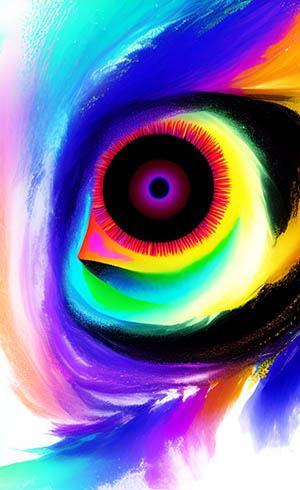The Relationship between Creativity and Synesthesia
The relationship between creativity and synesthesia is a topic that has fascinated scientists and artists for decades. Synesthesia, a neurological phenomenon in which the stimulation of one sensory pathway triggers the involuntary stimulation of another pathway, has been linked to increased creativity and artistic ability. In this article, we'll explore the relationship between synesthesia and creativity in more detail.
What is Synesthesia?
Synesthesia is a condition in which a person experiences a crossover of senses. For example, a person with grapheme-color synesthesia may see colors associated with each letter or number they read or write, while a person with sound-color synesthesia may experience colors associated with specific sounds or music. Synesthesia can take many different forms and is believed to be a result of increased connectivity between different areas of the brain responsible for processing sensory information.

What is Creativity?
Creativity is the ability to produce something new or original, whether it be a work of art, a scientific breakthrough, or a novel idea. Creativity involves taking existing ideas or concepts and combining them in new and innovative ways. It is often associated with the arts, but creativity is also an important component of scientific and technological innovation.
The Link between Synesthesia and Creativity
Studies have found a positive correlation between synesthesia and creativity, suggesting that synesthetes may be more likely to have creative abilities than non-synesthetes. One possible reason for this link is that synesthesia allows for a unique and novel way of perceiving the world. By experiencing sensory information in a different way, synesthetes may be more likely to think outside the box and come up with new and innovative ideas.
Research has also found that synesthetes tend to be more creative in specific domains, such as music and the visual arts. For example, a study published in the journal Frontiers in Psychology found that synesthetes who experienced colors when listening to music were more likely to have a career in music or the arts than non-synesthetes. Similarly, a study published in the Journal of Neuroscience found that grapheme-color synesthetes had increased activity in brain regions associated with visual imagery when viewing art.
In addition to these correlations between synesthesia and creative ability, there is also evidence to suggest that synesthesia can directly enhance creativity. For example, synesthesia may allow for a more vivid and immersive experience of art or music, leading to a deeper emotional connection and a more profound creative response. Synesthesia may also enhance memory and attention, both of which are important components of creative thinking.
The Role of Synesthesia in Artistic Creativity
Many famous artists throughout history have been thought to have had synesthesia, including Wassily Kandinsky, Vincent van Gogh, and Franz Liszt. These artists often expressed their synesthetic experiences through their art, creating works that were characterized by vivid colors and abstract forms.
For example, Kandinsky, a Russian painter and art theorist, is known for his use of abstract forms and bright, bold colors. Kandinsky experienced synesthesia and believed that colors and shapes had inherent emotional and spiritual qualities. His synesthetic experiences influenced his art, leading to a unique and innovative style that was ahead of its time.
Similarly, van Gogh, a Dutch post-impressionist painter, is thought to have experienced synesthesia, with some scholars suggesting that his use of bold colors and swirling brushstrokes may have been influenced by his synesthetic perceptions. Liszt, a Hungarian composer and pianist, also experienced synesthesia and believed that specific keys and chords had associated colors and emotions.
The Future of Synesthesia Research
Despite the growing body of research on synesthesia and creativity, much is still unknown about the precise relationship between these two phenomena. Further research is needed to understand the underlying mechanisms that link synesthesia.